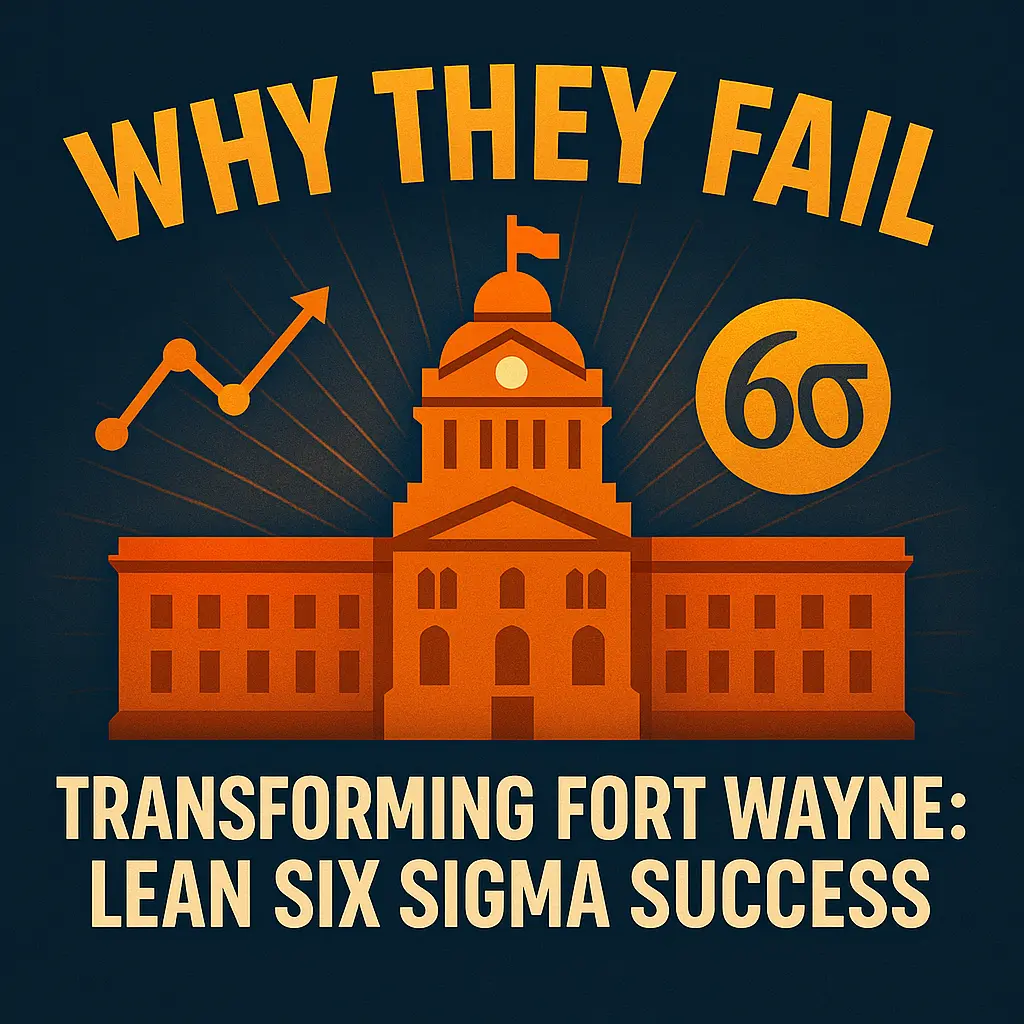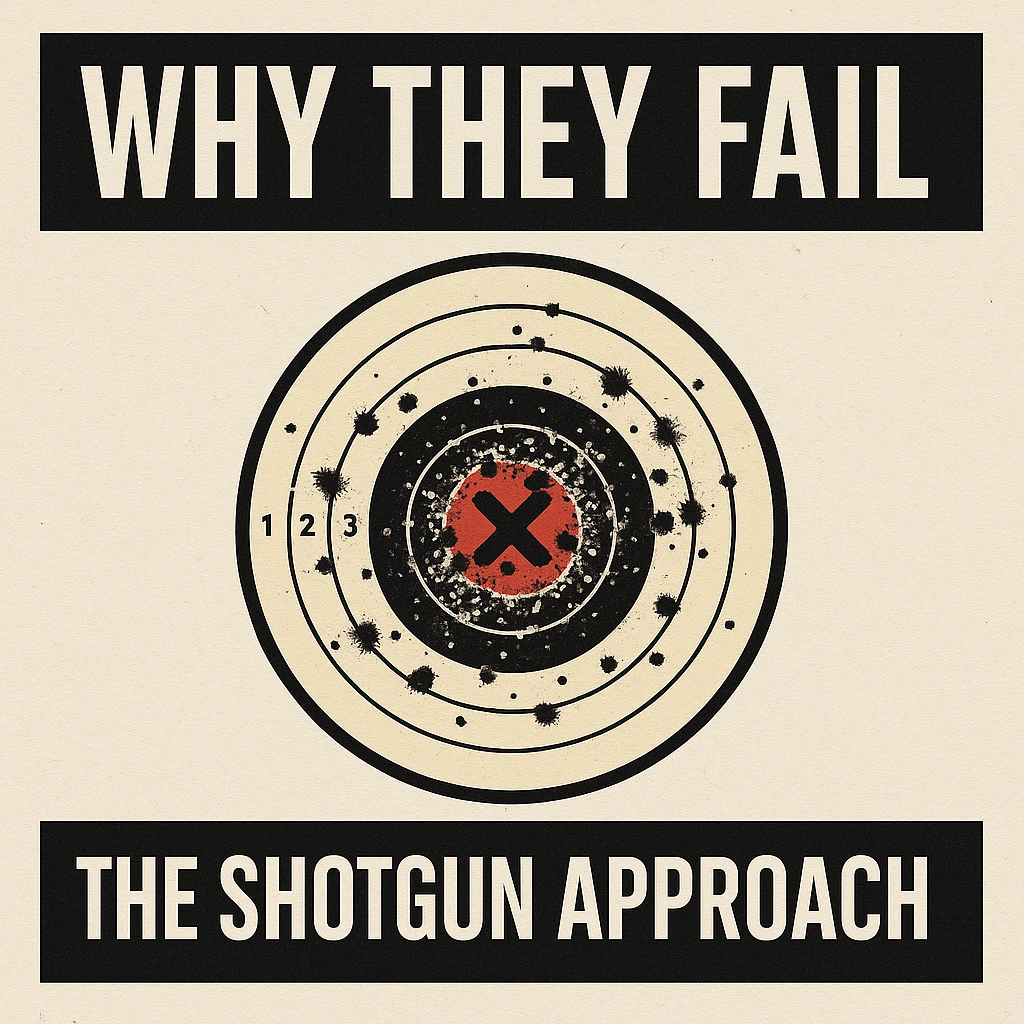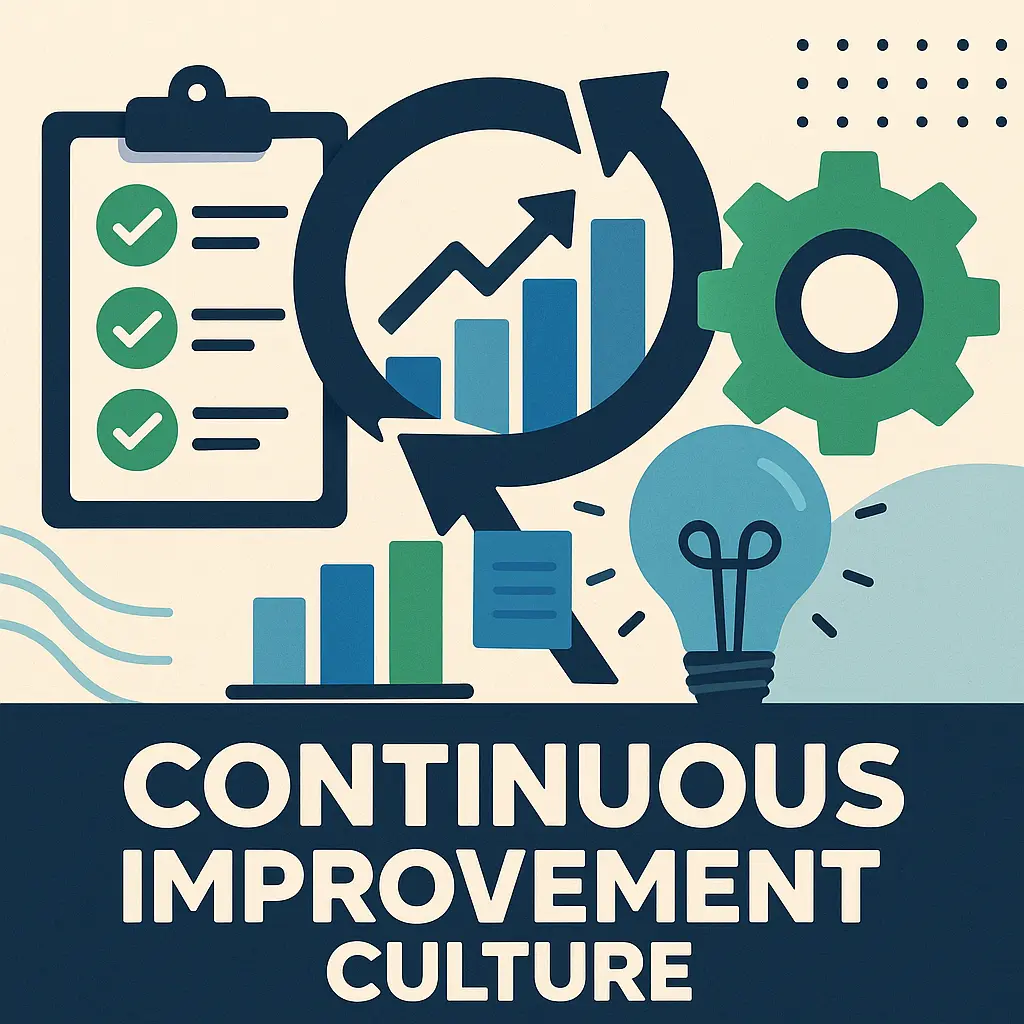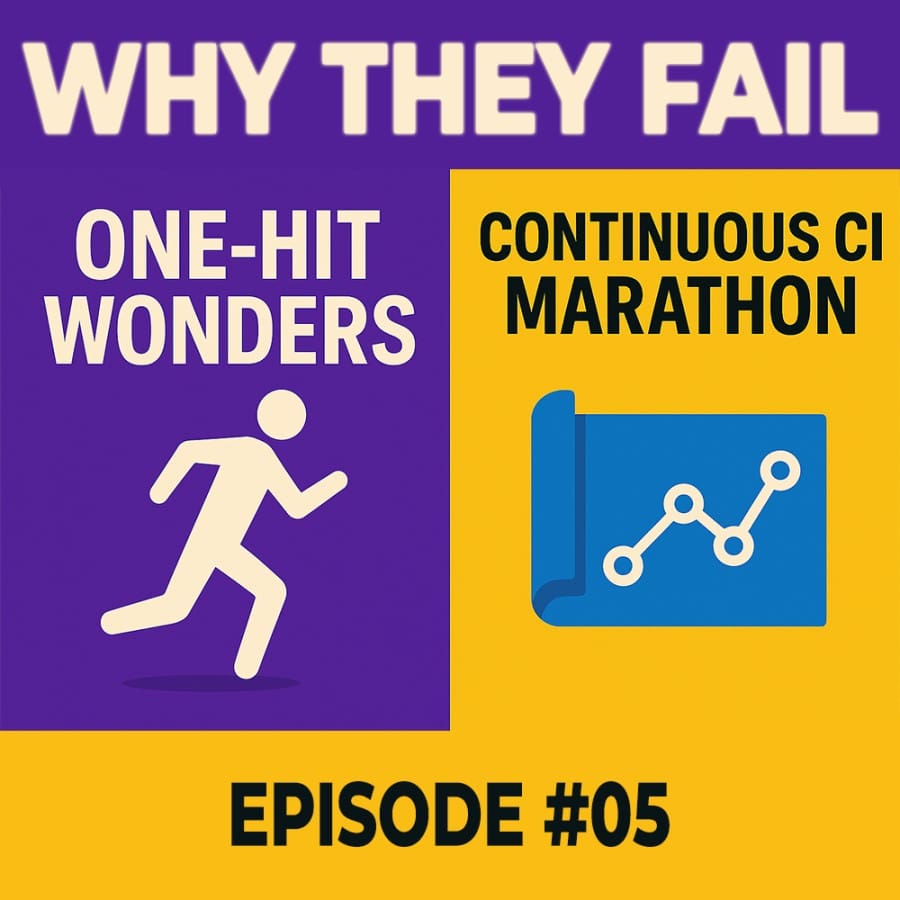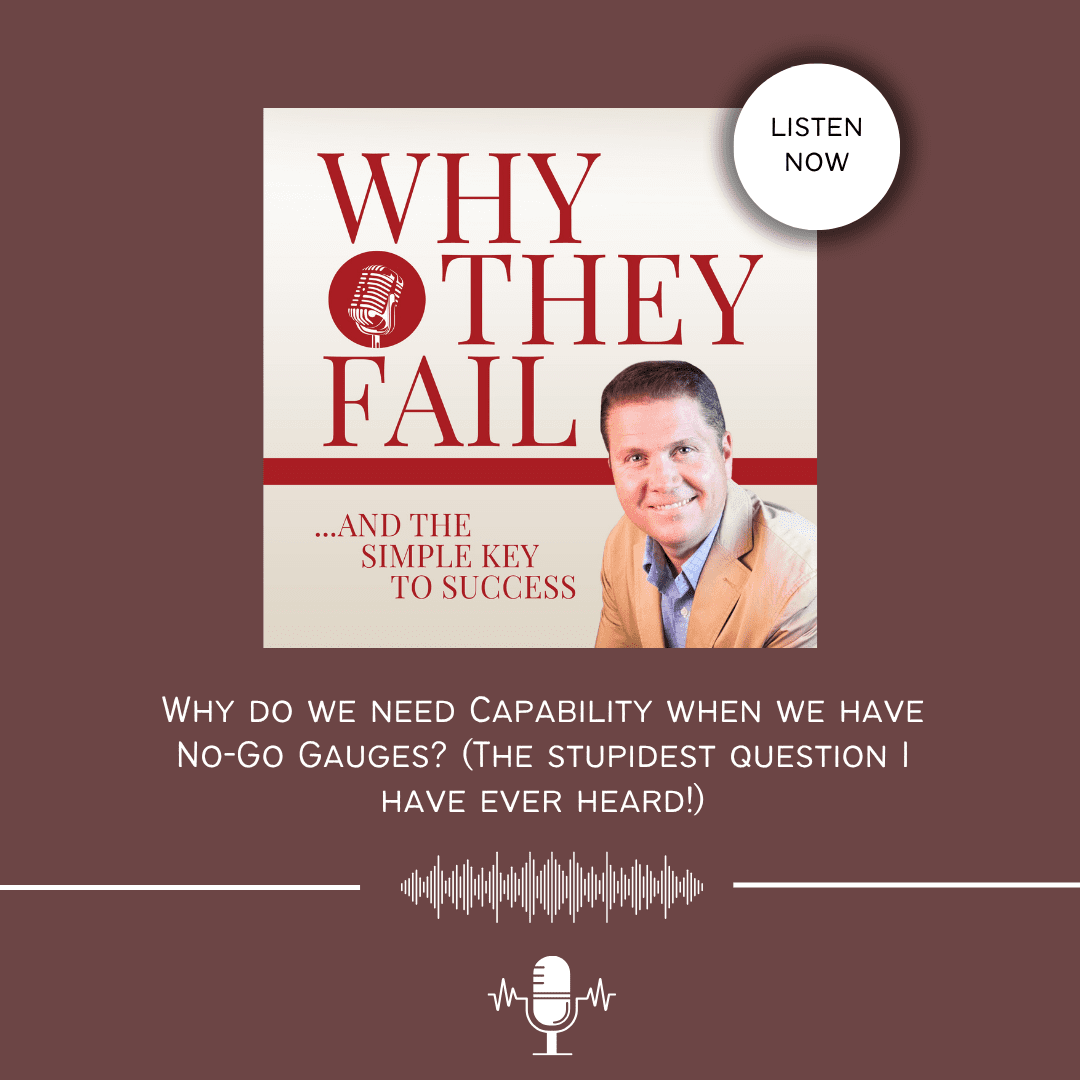Discover Why They Fail ... and the Simple Key to Success!
Why They Fail ... and the Simple Key to Success!

Why They Fail ... and the Simple Key to Success!
Author: Kevin Clay, Master Black Belt
Subscribed: 1Played: 3Subscribe
Share
© 2025 Six Sigma Development Solutions, Inc.
Description
Tired of watching continuous improvement efforts crash and burn? So are we. "Why They Fail" dives headfirst into the brutal truth behind failed Lean Six Sigma deployments, exposing the myths, the mistakes, and the outright absurdities that plague organizations worldwide. Forget the sugar-coated success stories—we're here to dissect the disasters, from executives who think training is optional to lone Green Belts drowning in unrealistic expectations. But it's not all doom and gloom. We'll also reveal the surprisingly simple key to unlocking sustainable success: ditching the quick fixes and building a rock-solid foundation. Buckle up, because this podcast is a no-holds-barred, reality check that will transform the way you think about continuous improvement.
15 Episodes
Reverse
How Lean Six Sigma Transformed a City Govt.
Can Lean Six Sigma principles truly revolutionize municipal operations? This episode delves into the remarkable success story of Fort Wayne, Indiana, exploring how continuous improvement in city government led to over $30 million in savings and drastically improved public services. Join host Kevin Clay as he interviews Graham Richard, the former mayor who pioneered this transformation. Discover the strategies, challenges, and incredible outcomes achieved by applying business process improvement methodologies in a public sector environment.
Graham Richard's Journey to Municipal Improvement
Graham Richard wasn't your typical politician entering office. With a background as a business owner and entrepreneur, he had hands-on experience with quality initiatives like TQM (Total Quality Management) even before Lean Six Sigma became prominent. Working with companies like General Electric, he saw the power of process analysis and data-driven decisions. This private sector experience became the bedrock for his vision when elected Mayor of Fort Wayne in 1999. He aimed not just to manage, but to fundamentally improve how the city operated.
Implementing Continuous Improvement in Fort Wayne
Upon taking office, Mayor Richard faced significant challenges: a city growing through annexation without immediate revenue increases, rising service demands, and tight budgets . His strategic answer was continuous improvement in city government, framed under the "B.E.S.T." (Building Excellent Services with Teams) initiative.
Instead of a top-down mandate, Richard focused on asking key questions: "Who is your customer?" "Is your service improving?" "How do you measure it?" . Initially met with blank stares, these questions sparked a shift towards a customer-centric, data-aware culture . Early projects were chosen for high visibility to build credibility and momentum, proving that these methods worked . A retired Master Black Belt from GE was hired, and partnerships were formed with local businesses to share expertise .
Key Successes and Savings
The results were tangible and impressive. By focusing on process analysis and data, Fort Wayne achieved significant gains:
Pothole Repairs: Cycle time reduced from 48 hours to less than 4 hours.
Permitting: Land improvement permit turnaround slashed from ~60 days to under 12 days.
Missed Garbage Pickups: Reduced by over 50%, saving the contractor (and indirectly, the city) nearly $200,000 annually.
Safety: Lost workdays due to accidents plummeted from over 1,900 in 2000 to under 100 in 2006.
Financial Impact: Documented savings exceeded $27-30 million over Richard's tenure, allowing the city to maintain service levels despite growth and achieve its lowest property tax rate since 1964.
These weren't just isolated wins; they represented a fundamental shift in operational efficiency and effectiveness, showcasing the power of continuous improvement in city government.
Chapters
(00:00:00) - Why They Fail(00:01:24) - Why They Fail: The Fight for High Performance(00:02:29) - Fort Wayne's commitment to Lean 6 Sigma(00:06:04) - Fort Wayne Mayor Richard Clay on Implementing Lean 6 Sigma(00:13:16) - Six Sigma and Fort Wayne City Government(00:21:16) - Best Teams in the Country(00:29:52) - Mayor Duggan on the City's Contract with the Union(00:39:55) - The City of Fort Wayne's automated 311 system(00:43:11) - The Long Term Impact of Continuous Improvement(00:45:59) - Why They Fail & How to Avoid It
Continuous Improvement at Danone: The Shotgun Approach
Welcome to our latest episode! We dive into Continuous Improvement at Danone, a global leader that embeds operational excellence into its culture. In this episode, I talk with Cici Haines, Danone’s Continuous Improvement Manager, who shares insights from her 20-year journey. We explore their “shotgun approach.” Hundreds of employees tackle both big and small problems.
This conversation centers on a key debate. Should you focus only on KPI-driving projects, or invest in culture-building quick wins? Danone’s method boosts morale and work-life balance. However, it also raises questions about focus, resource allocation, and sub-optimization risks.
Key Takeaways from this Podcast:
The shotgun approach empowers all employees, especially Yellow Belts, to solve problems within their influence.
Moreover, leadership and ambassadors filter and prioritize projects to align with team objectives.
There’s a constant balance between KPI-driven initiatives and quick wins that improve daily work life.
A structured system of virtual Kaizen boards and regular meetings tracks progress and shares successes.
True continuous improvement demands constant adaptation and re-engagement in a changing environment.
Understanding the Approach to Continuous Improvement at Danone
Danone believes employees closest to a process improve it best. Rather than top-down, Danone’s infrastructure welcomes ideas from everyone. Additionally, ambassadors and team leaders champion small projects to ensure needed support. They use virtual Kaizen boards to track ideas from definition through control, creating a transparent system.
This strategy relies on an army of trained Yellow Belts equipped with tools for quick wins. A perfect example: a project reduced cost-center creation from 11.5 days to just 5.25 days, smashing their goal!
The Great Debate: Strategic Projects vs. Cultural Wins
Quick wins boost morale, yet they pose a challenge. As my book explains, if you don’t prioritize projects by KPI impact, you may improve non-critical steps. Consequently, you risk sub-optimization. Cici explains that while some projects target cash collection and other KPIs, others focus on employee well-being. For an accounting team closing books late, saving two hours a month is a massive win that builds CI buy-in. Department leaders act as the first line of defense, ensuring teams work on the right projects.
Free Copy of my book "Why they Fail … and the Simple Key to Success"
Are you trying to build a continuous improvement culture that lasts? My book uncovers why over 90% of CI initiatives fail within 18 months and provides a simple 7-step roadmap for sustainable success. It covers failure scenarios, from lack of executive buy-in to treating CI as a “new toy.” If this episode’s challenges resonate, download your free PDF copy here: https://sixsigmadsi.com/product/why-they-fail-free-copy/
A Word from our Sponsor, Six Sigma Development Solutions.
This episode of "Why They Fail" is brought to you by Six Sigma Development Solutions, Inc., providing “Operational Excellence” Around the Globe!
Six Sigma Development Solutions, Inc. offers comprehensive Lean...
Chapters
(00:00:00) - Why They Fail(00:01:04) - Danone's Continuous Improvement: The Process(00:02:06) - What was your catalyst that really got you into Continuous Improvement?(00:03:42) - How to Continuous Improvement at Denone(00:06:16) - What is the Continuous Improvement Structure at your Company?(00:14:25) - Six Sigma: Continuous Improvement Champions and Green Belt Training(00:19:40) - A Taste of Continuous Improvement at Denone(00:20:53) - Why Performance Is the Best Politics
Shainin and Six Sigma: It All Comes Down to Leadership
Welcome to another episode of Why They Fail. In this episode, we explore the heart of every successful continuous improvement effort: leadership. Many companies invest in Lean Six Sigma or the Shainin Red X method, yet most fail to sustain progress. The reason is rarely the tools. It is almost always the leadership behind them.
We sit down with Craig Hysong, President and CEO of Shainin, to understand how leadership shapes a problem-solving culture. Craig shares his journey, including the moment he discovered the Shainin approach while working as a young engineer at General Motors.
He explains how the Red X method identifies the single dominant cause of a problem, cutting through the noise of endless variables. We also explore how Shainin and Six Sigma share a strong foundation in data-driven analysis and root cause thinking. But as Craig reminds us, no method works without strong, committed leadership.
The Leadership Factor in a Problem-Solving Culture
Craig emphasizes that lasting improvement depends on leaders who act, not just talk. Training teams is not enough. Successful continuous improvement begins with a clear vision, a sense of urgency, and consistent communication from the top. Leaders must connect improvement projects directly to key business goals.
He introduces Shainin’s Rolling Top Five, a simple yet powerful framework for keeping improvement alive. This approach pushes leadership to focus on the few projects that matter most. It ensures every action aligns with measurable results.
Craig also shares an effective accountability practice. Instead of project leaders giving updates, sponsors present progress directly to senior management. This shift keeps leadership engaged and invested. It builds ownership and turns continuous improvement into a daily habit, not a side project.
Key Takeaways from this Podcast
The Pareto principle applies. One root cause, the Red X, often drives most variation.
True learning comes from real projects, not just certification.
Leadership is the difference between success and failure.
Sponsors should present project updates to senior leadership for accountability.
Continuous improvement thrives when leadership focuses on the vital few projects that move the business forward.
Shainin Problem Solving Disciplines
Mastering problem solving is a necessary skill in multiple areas of any business. Each of Shainin's problem solving strategies has a specific place to be applied. Their methods can be used to:
Reactively solve an existing problem in Product Performance or Manufacturing Performance with Red X
Proactively prevent issues for Product and Process Design with Resilient Engineering
Target trouble within complex business processes with TransaXional Problem Solving
Structure an efficient problem solving program to enhance a problem solving culture with Rolling Top 5 Leadership
Depending on your current needs and future goals, one or all of these disciplines may be t...
Chapters
(00:00:00) - Why Continuous Improvement Efforts Fail(00:01:36) - Why They Fail(00:02:51) - Red X: The Science of Problems(00:12:12) - Problem Solving with 6 Sigma and Red X(00:22:17) - Employee Experience: The Pareto Principle(00:24:17) - What separates a Continuous Improvement Organization from one that Live Continuous Improvement?(00:26:41) - The Continuous Improvement Training Infrastructure(00:28:36) - Sustainability in the Continuous Improvement Program(00:33:15) - The Assessment of Competent People(00:35:38) - How to Get Your Lean 6 Sigma Certification(00:38:46) - A Moment With Shannon
Cracking the Code of a Continuous Improvement Culture
Building a lasting continuous improvement culture is one of the biggest challenges for any company. Studies show that more than 90% of these efforts fail or fade within 18 months. This happens not because of the tools but because teams misunderstand what it really takes to build a culture that lasts. Many companies chase quick fixes or depend on leadership that only talks about improvement but does not live it. These habits cause most programs to fail before they start.
In this episode, we talk with Kurt Niemann, Master Black Belt and Principal IT Quality Improvement Specialist at Discount Tire. Kurt shares lessons from his 40-year career at Rolls-Royce, Honeywell, and Allied Signal. He explains the difference between working in a company that already has a continuous improvement culture and building one from scratch.
The Pitfalls of a Flawed Continuous Improvement Culture
One of the fastest ways to fail is when leaders only give lip service. Kurt recalls his time at Allied Signal, where every employee was Green Belt trained. Continuous improvement was part of daily work, not an extra task. This kind of company culture builds accountability and ownership across every level.
In contrast, many organizations train one person and expect them to solve everything. That lone Green Belt faces burnout because there is no system, no shared responsibility, and no leadership support.
When leadership picks projects based on personal pain points rather than data, the results are short-lived. Fixing a local issue might make one area look better, but the whole system stays the same. True continuous improvement depends on data, not opinions. It must target the real constraint that slows down performance.
Building a Sustainable CI Framework
So how can a company build a CI system that lasts? It starts with a solid foundation before any formal training begins. Kurt explains that you need to meet people where they are. You can’t copy-paste someone else’s culture.
At Discount Tire, the team started with a simple operating system similar to the Plan-Do-Check-Act cycle. It fit the company’s way of working and evolved naturally. A key part of this system is tracking performance with Key Performance Indicators (KPIs). These metrics show where the business struggles, so teams know exactly which process needs attention next.
Instead of guessing or reacting to the problem of the day, the data leads the way. Every project connects to a clear business goal. That approach builds trust, focus, and long-term growth.
This method reflects what Lean and Six Sigma stand for, continuous improvement that grows from within the organization.
Key Takeaways from this Podcast:
Executive buy-in must be active and informed, not empty talk.
One Green Belt cannot carry an entire continuous improvement effort.
Use data and KPIs to decide which projects matter most.
Build a strong foundation before starting any CI program.
Agile and Lean principles work hand in hand to improve IT and operations.
A Word from our Sponsor, Six Sigma Development Solutions.
This episode of "Why They Fail" is brought to you by Six Sigma Development Solutions, Inc., providing “Ope...
Chapters
(00:00:00) - Does automation improve the business process?(00:00:41) - Why They Fail: Continuous Improvement ((00:03:13) - Continuous Improvement at Honeywell(00:08:31) - Bradley on the Lean and Six Sigma Culture(00:09:23) - Expert Experience in Continuous Improvement at Honeywell(00:14:09) - What led you from one to the other?(00:16:23) - Discount Tire: Moving From Lean to Six Sigma(00:21:27) - Continuous Improvement at Discount Tire(00:25:10) - Defect Capture Log(00:28:27) - Exploring Continuous Improvement at Rolls Royce and Honeywell(00:31:03) - Automation vs Continuous Improvement: Do We Automate Everything?(00:35:08) - How to Build a Continuous Improvement Culture
Lean Six Sigma in Healthcare: Lessons from Eddie Conklin
Welcome to the latest episode of Why They Fail podcast. In this episode, host Kevin Clay speaks with Eddie Conklin, a veteran of continuous improvement with over 40 years of experience in both manufacturing and healthcare. Eddie shares how early lessons from factory floors shaped the way he now transforms operating rooms, sterile cores, and hospital systems.
From Factory Floors to Operating Rooms
Eddie’s journey began at just 16 years old, working alongside industrial engineers in his father’s factory. Those early experiences taught him the value of process improvement, efficiency, and safety. Later, concepts like Single Minute Exchange of Dies (SMED), originally designed for quick tool changes in manufacturing, would become powerful solutions in healthcare, reducing operating room turnover times and enabling more patients to be treated each day.
Applying Lean Tools in Healthcare
Eddie explains how tools such as 5S and Kanban improved hospital inventory systems. By rethinking sterile core storage and implementing right-sizing strategies, his team eliminated hoarding, reduced expired materials, and ensured critical sets were always available when surgeons needed them.
Visual management, daily huddles, and Andon-style signals helped frontline staff and leadership align in real time, creating a culture of continuous flow.
The Power of Data as a Myth Buster
While Lean tools streamline processes, Eddie emphasizes that data is gospel. In both steel mills and hospitals, data analysis shattered long-held assumptions, exposing root causes that intuition and tradition had overlooked. From staffing plans in central processing to infection control analysis, Six Sigma methods turned anecdotal beliefs into measurable, lasting improvements.
Building a Culture of Continuous Improvement
Beyond tools and data, Eddie stresses the importance of infrastructure and culture. Leadership walking the floor, cross-functional collaboration, and effective huddles ensure improvements are sustained. Just as in manufacturing, breaking down barriers between management and frontline teams creates trust, accountability, and results.
Key Takeaways from this Episode
⚙️ Lessons from manufacturing, like SMED, 5S, and Kanban, directly improve hospital efficiency.
Data-driven analysis is essential to bust myths, expose true root causes, and guide staffing and scheduling.
Continuous improvement in healthcare requires both quick fixes for stability and structured Six Sigma projects for long-term impact.
Culture matters: huddles, visual management, and leadership presence are as important as statistical tools.
The ultimate goal of Lean Six Sigma is continuous flow - whether in a factory or an operating room.
About Six Sigma Development Solutions
This episode of "Why They Fail" is brought to you by Six Sigma Development Solutions, Inc., providing “Operational Excellence” Around the Globe!
Six Sigma Development Solutions, Inc. offers comprehensive...
Chapters
(00:00:00) - Why They Fail: Continuous Improvement(00:01:25) - Lean Six Sigma: From Factory Floor to Operating Room(00:09:05) - Sterile Core Inventory Modernization(00:13:23) - How Six Sigma Impact on the Healthcare Process(00:19:40) - The thermal cycling of ingots(00:20:43) - How Six Sigma Works in the Hospital(00:28:07) - What was some of the biggest struggles at Microwave?(00:29:44) - Design Engineering and the Visual Factory(00:34:37) - What was your most unexpected obstacle to a Lean Six Sigma Project?(00:35:57) - WTF
Shainin: The Problem-Solving Method You Haven't Heard Of
Welcome to the show notes for the "Why They Fail" podcast. In this episode, host Kevin Clay introduces a powerful and lesser-known precursor to Six Sigma. He sits down with Brian St. Pierre, an expert in Shainin Red X Problem Solving, to explore this unique methodology. You’ll learn how this approach has been a game-changer in various industries, tackling everything from exploding pipelines to nanometer-scale issues on semiconductor chips.
An Introduction to Shainin Red X Problem Solving
So, what exactly is the Shainin methodology? At its core, it's a structured approach for solving technical problems, especially those with hidden root causes. Brian explains that while there can be countless factors affecting a process, Shainin operates on the principle that one primary driver, the "Red X," is responsible for the most variation. By focusing on and eliminating this single dominant cause, you can achieve the biggest impact with the least amount of effort. This contrasts with other methods that may try to address multiple variables at once.
How Shainin Differs from Six Sigma
A key difference between Shainin and Six Sigma lies in their approach to problem-solving. Traditional methods often move from potential causes (the X's) to the problem (the Y). However, Shainin works backward. It starts with the defect—the Y—and uses clues to trace back to the Red X. This is accomplished through a technique called a "progressive search," which Brian demonstrates with a simple deck of cards analogy.
In addition, the statistical tools used in Shainin are designed to be practical and graphical, making them accessible to everyone, not just statisticians. This simplicity and the methodology's strict IP control have helped maintain its integrity over the years, preventing the "watering down" that has affected some Six Sigma certifications.
Shainin’s Historical Significance
The impact of this methodology extends beyond the factory floor. Dorian Shainin, the creator, played a crucial role in the Apollo space program by handling the reliability of the lunar module. His work ensured the module could withstand extreme stress, a factor that was critical in the safe return of the Apollo 13 astronauts.
Furthermore, Shainin's work with Motorola in the 1980s was a foundational element of what would become the Six Sigma revolution. The highest award given by the American Society for Quality is even named in his honor, a testament to his contributions.
Key Takeaways from this Podcast:
Shainin focuses on a single dominant cause, the "Red X," to solve complex technical problems.
The methodology works backward from the defect to uncover the root cause efficiently.
Its tools are graphical and practical, making complex statistics easy for anyone to understand.
Dorian Shainin was responsible for the reliability of NASA's Apollo lunar module.
️ Strict IP control has maintained the integrity of the Shainin methodology and its certifications.
A Word from our Sponsor, Six Sigma Development Solutions.
This episode of "Why They Fail" is brought to you by Six Sigma Development Solutions, Inc., providing “Operational Excellence” Around the Globe!
Six Sigma Development Solutions, Inc. offers comprehensive Lean Six Sigma certification training, accredited by the International Association for...
Chapters
(00:00:00) - Why They Fail: Continuous Improvement (CI)(00:01:32) - Why They Fail: Shannon ((00:02:35) - Brian St Pierre on Lean 6 Sigma(00:05:43) - Bradley on Shannon and Six Sigma(00:11:23) - Lean 6 Sigma vs. 6 Sigma(00:14:13) - Shannon vs. Six Sigma: A Comparison(00:17:51) - Lean vs. Pareto: The Differences(00:23:05) - Quantitative and Quantitative Tools for Algorithm(00:25:10) - Six Sigma Training: Don't Get Scared of Statistics(00:32:55) - Six Sigma and Resilient Engineering(00:33:46) - Chain in the Red X(00:36:08) - Why Continuous Improvement Efforts Fail
"Lip Service" Leadership in Six Sigma: Why CI Efforts Fail
Have you ever been part of a promising continuous improvement initiative that just... fizzled out? The energy was high, the goals were set, but somewhere along the way, it lost steam and failed to deliver results. The problem often isn't the methodology or the team; it's a destructive pattern known as "lip service" leadership in Six Sigma. This is when executives say they support change, but their actions prove otherwise, effectively killing progress before it can even take root. In this episode, we pull back the curtain on this all-too-common issue and reveal why genuine, engaged leadership is the ultimate key to success.
What is "Lip Service" Leadership in Six Sigma?
At its core, "lip service" leadership in Six Sigma is the disconnect between what leaders say and what they do. They might enthusiastically approve a new CI program in the boardroom, but when a project conflicts with their personal agenda or requires real resources, their support vanishes. This creates a culture of confusion and mistrust, where data-driven improvement is constantly undermined by subjective decision-making. Consequently, team members become demoralized, knowing that their hard work can be undone by a leader's whim. This insincere support is the single biggest predictor of failure for any continuous improvement deployment.
The Symptoms of Ineffective Six Sigma Leadership
How can you spot this destructive pattern in your organization? It often manifests in several predictable ways. First, leaders will ignore established, data-driven systems in favor of their own intuition. In addition, they place unrealistic expectations on individuals without providing the necessary support structure.
A few key symptoms include:
️ Ignoring the Project Hopper: A healthy CI culture collects improvement ideas from everyone in the organization through a project hopper. However, in a "lip service" environment, leaders ignore this valuable resource and instead hand-pick projects based on their personal priorities.
Reacting to the "Pain of the Day": Instead of focusing on projects that impact key performance indicators (KPIs), leaders will chase the latest "shiny object" or react to the most recent problem they've experienced. This leads to sub-optimization, where minor issues are addressed while critical problems are ignored.
Asking One Person to "Save the World": A common mistake is training a single Green Belt and expecting them to single-handedly fix systemic organizational problems. This sets the individual up for failure and ensures the CI effort is not integrated into the company culture.
Killing Inconvenient Projects: The clearest sign of lip service is when a project is shut down because it exposes an uncomfortable truth or gets in the way of a leader's pet project. When this happens, the message is clear: the agenda is more important than actual improvement.
The True Role of Leadership in Continuous Improvement
So, what should a leader's role be? Instead of dictating projects, effective leaders focus on building the foundation for a sustainable CI culture. Their job is not to be the primary problem-solver, but to empower their teams to succeed. Therefore, their focus should be on creating systems and removing barriers.
A truly s...
Chapters
(00:00:01) - Why They Fail(00:00:59) - Why Continuous Improvement Initiatives Crash and Burn(00:02:20) - What If You Can't Lead the Six Sigma Project?(00:04:20) - 7 signs of a Lean Six Sigma culture(00:07:37) - The CI Turbine War(00:09:08) - What Should Leadership Be Doing to Make Six Sigma More Successful?
Army Six Sigma Black Belt Project Eliminates Waste
In this episode of Why They Fail, host Kevin Clay speaks with U.S. Army Officer Edriece Patterson about his Army Six Sigma Black Belt project. The discussion highlights how Lean Six Sigma methodologies solve complex non-manufacturing challenges inside a military environment.
Edriece, a West Point graduate, recognized a chance to address the Army’s notorious “hurry up and wait” culture. He focused on streamlining a critical administrative task: the orders publishing process. By improving this workflow, the project became a powerful example of how Lean Six Sigma drives efficiency in transactional operations, not just factory floors.
The Challenge of an Army Process Improvement Project
While serving in his unit’s operations shop, Edriece identified waste in the orders process. Orders were received, crafted, and published with long delays and frequent rework. Inconsistent results meant that the same task could take hours longer depending on who handled it.
Before the project, publishing an order required an average of 6.75 hours. The large variation confirmed the process was unstable and out of control. This bottleneck consumed valuable time and slowed down critical Army operations.
Executing the Army Six Sigma Black Belt Project with DMAIC
Edriece applied the DMAIC framework (Define, Measure, Analyze, Improve, Control) to guide the project. During the Analyze phase, he used a Design of Experiments (DOE) approach. Although many assume DOE is only for manufacturing, he proved it is equally effective for administrative processes.
The DOE analysis revealed two main delay factors: operator experience and time spent waiting for review.
With these insights, the Improve phase delivered clarity. Edriece developed a robust Standard Operating Procedure (SOP) and trained more personnel to follow the same standard. Consequently, the average process time dropped to 6.25 hours. More importantly, variation decreased sharply, making the process reliable and predictable.
This successful Army Six Sigma Black Belt project shows that a data-driven strategy outperforms guesswork or opinion-based problem solving.
Key Takeaways from this Podcast:
Lean Six Sigma improves administrative and transactional processes, not only manufacturing.
Data-driven tools such as Design of Experiments deliver clarity that opinions cannot match.
Clear SOPs reduce variation and improve consistency across teams.
Cross-training personnel prevents bottlenecks and ensures operational resilience.
The Army Ignited Credentialing Assistance Program helps soldiers earn professional certifications like the Lean Six Sigma Black Belt.
A Word from our Sponsor, Six Sigma Development Solutions.
This episode of Why They Fail is sponsored by Six Sigma Development Solutions, Inc., a global leader in Lean Six Sigma certification training.
We are an Authorized Training Organization accredited by the International Association for Six Sigma Certification (IASSC). Our programs have transformed more than 100 organizations across 52 countries, delivering over $100M USD in savings and certifying 4,000+ practitioners. Our trusted partners include Aerojet Rocketdyne, Dropbox, and Mercy Health.
Key Certification Training we provide:
Chapters
(00:00:00) - Why They Fail: Continuous Improvement ((00:01:12) - Why They Fail(00:02:07) - How to Get Your Lean 6 Sigma Black Belt(00:05:12) - Waste in the 6 Sigma Process(00:12:55) - Experiential learning in the Army(00:15:30) - What kind of effect did it have on the process(00:17:48) - The DMAIC Process(00:21:44) - Why They Fail: Edris's Story
Stop 'Doing' Six Sigma (and Start Actually Fixing Things!)
Tired of watching continuous improvement efforts fall flat? In this powerful episode of "Why They Fail," host Kevin Clay sits down with the legendary six sigma pioneer Mike Carnell, who was there for its genesis at Motorola. If you feel like your company is just going through the motions of Lean Six Sigma without seeing real results, this conversation is for you. Forget the buzzwords and the "motivational fluff." This is a deep dive into what truly works.
Mike shares unfiltered truths from his decades of experience, including an unforgettable lesson learned directly from GE's Jack Welch. He explains why your job isn't to "do" Six Sigma but to solve critical business problems. This episode dissects the short-sighted decisions and leadership agendas that sabotage success and gives you the simple keys to avoid these all-too-common pitfalls.
A Glimpse into the Mind of Six Sigma Pioneer Mike Carnell
Mike Carnell’s journey didn't start in a boardroom; it began at Motorola after his time in the Marine Corps. A pivotal moment for him was witnessing a complex, 19-year-old product defect get solved in just three days by an expert using a component search technique. That was the spark. He realized the goal wasn't just to follow a rigid process but to use the right tool for the job.
Throughout his career, Mike has seen it all. He emphasizes that no two companies are the same, and therefore, no two improvement programs should be identical. He argues against being a "zealot" for one specific methodology, whether it's Lean, Six Sigma, or TQM. Instead, the focus must always be on a simple question: what problem are we trying to fix?
The Non-Negotiable Need for Leadership and a Plan
A recurring theme in the discussion is the absolute necessity of a solid plan and strong leadership. Mike recounts how the most successful deployments he's been a part of started with a clear, measurable target from the top. For example, a CEO asking for a "$98 million in EBIT improvement over the next two years" provides a much clearer direction than just saying "we want to do Six Sigma."
This is where so many companies fail. They send employees to get Green Belt training without having any projects ready for them. As Kevin and Mike agree, if your newly trained Belts have to go find their own projects, your deployment has already failed. A successful initiative requires building a detailed plan before you ever start training, just like you need a blueprint before you start building a house. Furthermore, the leadership must be disciplined, engaged, and hold people accountable, a trait Mike saw firsthand while working with Jack Welch at GE.
Key Takeaways from this Podcast:
Your job isn't to "do" Six Sigma; it's to solve problems and improve the company.
If your Belts have to find their own projects, your continuous improvement effort has already failed.
Strong leadership with a clear, measurable goal is the ultimate key to success.
️ Don't be a zealot for one methodology; use the right tools from Lean, Six Sigma, Shainin, or TQM to fix the problem at hand.
You must build a detailed plan and have leadership buy-in before you ever swing a hammer or train a single person.
A Word from our Sponsor
This episode of "Why They Fail" is brought to you by Six Sigma Development Solutions, Inc., providing “Oper...
Chapters
(00:00:00) - Projects for Lean and Six Sigma(00:00:47) - Why They Fail(00:01:47) - Mike Pompeo Just Got Back from...(00:02:12) - Mike Galton on Six Sigma and Continuous Improvement(00:06:59) - Six Sigma vs Lean: A Word for Newcomers(00:12:55) - Lean and Safeguard: The Plan(00:17:52) - Five Rules for Six Sigma Deployments(00:21:03) - How to manage a Kaizen project?(00:23:23) - Mixed Qualities of a Leader(00:28:18) - On Jack Welch's Fire(00:29:24) - 7 Steps to Continuous Improvement(00:31:33) - Belt Standards(00:37:08) - On Certification and HR(00:42:51) - Lean and Six Sigma: The Essential Skills
Why They Fail!, Episode #6 - LEAN "Snake Oil", the LEAN Only Approach
Welcome back to "Why They Fail," the podcast that dissects the real reasons continuous improvement initiatives don't last. In this episode, host Kevin Clay tackles a pervasive and damaging trend he calls LEAN Snake Oil. Have you been told that LEAN is the one and only answer to your business problems? Have consultants promised you a swift transformation with a few simple, data-free tools? This alluring promise of a quick fix is incredibly common, but it's a trap that sets organizations up for failure. We’ll explore why this incomplete solution is so popular and how it cripples your ability to create lasting change.
This episode dives into the widespread fear of data that pushes leaders toward what feels easy and tangible. However, relying on gut-feel and qualitative tools alone is like operating with only half of your brain. True, sustainable improvement requires a more robust approach. Therefore, we uncover why ignoring the analytical rigor of Six Sigma is a critical mistake that leaves your improvements vulnerable to failure over time.
The Problem with a LEAN-Only Approach
A key reason that peddlers of LEAN Snake Oil are so successful is that they validate a common fear: "paralysis by analysis". Leaders are often conditioned to make decisions based on experience and intuition. When a consultant offers a solution that avoids complex data, it feels like a relief. But this comfort comes at a high cost. As Kevin explains, LEAN and Six Sigma are like the two hemispheres of the brain; you need both to function optimally. LEAN represents the creative, hands-on "right brain," using tools like Value Stream Mapping to visualize waste. In contrast, Six Sigma is the logical, analytical "left brain" that uses data to prove what is actually happening. To rely only on LEAN is to willingly ignore half of the equation.
For instance, consider the powerful analogy of two football kickers. One kicker is accurate, getting 100% of his kicks through the uprights. From a LEAN-only perspective, he is a total success. However, his kicks are all over the place—some barely inside the left post, others just inside the right. The second kicker also scores 100% of the time, but every single ball he kicks sails directly through the center with almost no variation. He is both accurate AND precise. Six Sigma is the toolset that allows you to see this crucial difference and build a process that is not just good, but consistently perfect and reliable under pressure.
Key Takeaways from this Podcast:
A LEAN-only approach is like operating with only half a brain.
Fear of data and "paralysis by analysis" drives leaders to adopt incomplete solutions.
Being accurate isn't enough; your processes must also be precise to be reliable.
Six Sigma provides the analytical tools to measure and reduce variation for precise results.
True, sustainable success requires courageously integrating both LEAN and Six Sigma.
A Word from our Sponsor
This episode of "Why They Fail" is brought to you by Six Sigma Development Solutions, Inc., providing “Operational Excellence” Around the Globe!
Six Sigma Development Solutions, Inc. offers comprehensive Lean Six Sigma certification training, accredited by the International Association for Six Sigma Certification (IASSC) as an Authorized Training Organization. They have transformed over 100 organizations...
Why They Fail!, Episode #5 - The "One-Hit Wonders"
Have you ever watched your company invest heavily in training Lean Six Sigma Green Belts, only to see their impact vanish after one project? In this episode, host Kevin Clay examines this costly “one-hit wonder” syndrome. He explains why organizations train these champions then accidentally sideline them, derailing continuous improvement from the start. As a result, resources go to waste and CI efforts collapse within 12–18 months.
The Frustrating Reality of "One-Hit Wonder" Green Belts
First, we explore how a successful certification project can end up being a Green Belt’s last assignment. Leadership often assumes training alone creates change. Without a system for identifying and prioritizing new projects, these belts are left idle. Consequently, the CI program loses momentum and confidence.
Why Continuous Improvement Grinds to a Halt
Next, we show why a reactive approach fails. When companies treat Green Belts as “firefighters” rather than strategic agents, projects lack alignment with key performance indicators. Moreover, without leadership buy-in or a clear deployment plan, even well-trained belts chase random initiatives that yield little ROI. Therefore, CI programs quickly grind to a halt.
Building the Foundation for Sustainable Success
Instead, build a robust CI infrastructure upfront. Start with a 12–36-month deployment roadmap tied to company KPIs. Then secure formal leadership commitment, ensuring executives stay actively engaged. Finally, implement a dynamic project hopper that captures the “Voice of the Operator” and prioritizes projects by strategic impact. This system empowers Green Belts to drive continuous, organization-wide improvements.
Key Takeaways from this Podcast:
Many companies create "one-hit wonder" Green Belts who complete one project and are never used again.
This failure is caused by a lack of infrastructure, not a lack of skill or motivation from the belt.
️ A successful CI program requires a long-term deployment plan aligned with company KPIs.
A project hopper is essential to systematically identify and prioritize the right projects to work on.
True leadership buy-in is more than lip service; it requires active engagement and accountability.
A Word from our Sponsor, Six Sigma Development Solutions.
This episode of "Why They Fail" is brought to you by Six Sigma Development Solutions, Inc., providing “Operational Excellence” Around the Globe!
Six Sigma Development Solutions, Inc. offers comprehensive Lean Six Sigma certification training, accredited by the International Association for Six Sigma Certification (IASSC) as an Authorized Training Organization. They have transformed over 100 organizations in 52 countries and achieved $100M USD in savings through Lean Six Sigma, certifying over 4000 practitioners. Their partners include Aerojet Rocketdyne, Dropbox, and Mercy Health, among others.
Key Certification Training we provide:
Lean Six Sigma Green Belt (https://sixsigmadsi.com/six-sigma-green-belt/)
Lean Six Sigma Black Belt (https://sixsigmadsi.com/s...
Chapters
(00:00:00) - Why They Fail(00:03:02) - The Process of Data-driven Improvement(00:03:47) - What Makes a Lean Six Sigma Green Belt(00:08:38) - What's the One Hit Wonder?(00:09:05) - 4 Pillar of a CI Deployment Plan(00:09:53) - The CIA's Two Key Elements(00:10:46) - 3 Critical Elements of a Solid Project Hopper(00:13:38) - What is Continuous Improvement (CI)?(00:15:13) - Six Sigma: Why They Fail and How to Turn Things Around(00:16:33) - How to Become a Patron on This Podcast
Why They Fail!, Episode #4 – “Why Capability?…”
Welcome to “Why They Fail,” the podcast that dissects the downfall of continuous improvement initiatives. Your host, Kevin Clay, a Lean Six Sigma Master Black Belt with over 25 years of experience and a mentor at Six Sigma Development Solutions, is here to deliver an unfiltered look at why so many continuous improvement efforts falter. We’re not sugarcoating anything; get ready for raw insights into the leadership agendas and shortsighted decisions that derail CI projects. But it’s not all doom and gloom—we’ll also unveil the surprisingly simple key to avoiding these pitfalls and building a phenomenal, sustainable data-driven improvement culture.
In our last episode, we explored whether your continuous improvement program is merely a “fad diet for your business,” much like personal weight loss journeys that chase quick fixes only to “crash and burn”. We discussed the sobering statistic from Pat Bergin, President of Aerofil Technology, who noted that a staggering 96 out of 100 companies undertaking continuous improvement fail or quit within 18 months. We also delved into common pitfalls such as the “Lone Ranger” approach, where a single Green Belt is expected to “save the world” without adequate support. Other issues included “stepping in someone else’s sandbox,” leading to turf wars and demoralized belts, and the futility of “trying to solve world hunger” by assigning overly broad projects. Finally, we highlighted how continuous improvement can become leadership’s “new toy,” resulting in arbitrary projects based on personal agendas rather than data-driven needs. The core message was clear: abandon quick fixes and build a strong foundation.
Today, we dive into a specific, baffling type of failure that reveals a fundamental misunderstanding of continuous improvement, particularly the Six Sigma aspect of Lean Six Sigma. This episode is titled “Why do we need Capability when we have Go/No-Go Gauges? (This is one of the stupidest question I have ever heard!)”. While the intent behind this question isn’t usually malicious, it signals a larger problem in how continuous improvement, especially Six Sigma, is taught and implemented.
Consider a scenario at a company that manufactures aluminum rims for automobiles, a plant seeking to replicate the success of its sister facility after a Lean Six Sigma deployment. During a performance discussion, the plant operations officer, himself a Black Belt, was asked about measuring the capability of their current process inputs. In manufacturing, wheel designs have specific dimensional attributes with Upper Specification Limits (USL), Lower Specification Limits (LSL), and a Target. Process capability is about understanding how consistently a process can produce outputs within these limits—a fundamental statistical concept in Six Sigma. His astonishing reply: “Why do we need capability when we have Go/No-Go Gauges?”.
Go/No-Go Gauges are simple inspection tools that provide a binary answer: good or bad. They don’t reveal
how good or bad, the extent of process variation, or if the process can consistently meet specifications over time. This COO also mentioned a dismal 62% yield, meaning many wheels had to be melted down and re-cast. This highlights an “epidemic” where Lean Six Sigma is often taught and implemented with a critical flaw. Many Lean Six Sigma “Black Belts” haven’t used statistics to solve process problems, though they are skilled in qualitative tools like Fishbone diagrams, 5-Why analysis, and Process Mapping. While these tools are essential for identifying potential root causes, they are qualitative and rely on subjective input, leading to varying results and not proving anything.
The true power of Six Sigma lies in its reliance on data and statistical analysis to validate hypotheses and identify actual root c...
Chapters
(00:00:01) - Why They Fail(00:00:32) - Why They Fail(00:02:16) - 6 Sigma: The Pitfall of Continuous Improvement ((00:04:10) - Lean Six Sigma: No Go Gauges(00:08:22) - Six Sigma Training: The Need for Hypothesis Testing(00:11:28) - No Go Gauges vs Process Capability(00:13:06) - Mastered Your Processes: The Lean 6 Sigma Mindset(00:16:17) - Six Sigma Development: Why They Fail(00:17:30) - How to Become a Million-Dollar Entrepreneur
Why They Fail!, Episode #3 – Beware of the Paper Belt!
Welcome to “Why They Fail,” the podcast that dissects why continuous improvement efforts often derail. Your host, Kevin Clay, a seasoned Lean Six Sigma Master Black Belt, is here to expose the truth behind leadership agendas and short-sighted decisions that cripple CI projects. In this unfiltered episode, we tackle a critical and infuriating reason why CI initiatives crumble: the rise of “paper belts”. If you’re tired of seeing continuous improvement fall flat, then this episode is for you!
Understanding the “Paper Belt” Phenomenon
So, what exactly is a “paper belt”? It’s insidious yet simple. A paper belt is someone who gains Lean Six Sigma certification, often a Green or Black Belt, merely by passing an exam, lacking practical project experience. Imagine getting a driver’s license just by passing a written test. It sounds absurd, but it happens all the time! Many certification exams allow endless retakes, valuing volume over actual competence.
The Real Danger of Paper Belts
The true danger emerges when these paper belts are hired to lead continuous improvement efforts. They come with a fancy certificate and a title, but often have no idea how to apply Lean Six Sigma principles in a real-world business environment. They understand the theory but lack critical thinking, problem-solving skills, and the hands-on experience only gained from navigating a true Lean Six Sigma project. These individuals misapply tools, chase incorrect metrics, alienate teams, and can even make business processes worse! This creates widespread cynicism, erodes trust in CI, and significantly contributes to the high failure rate of continuous improvement initiatives.
Why Does This Happen? Who’s to Blame?
A significant part of the blame rests with training companies that prioritize “quantity” over “quality”. They offer quick bootcamps focused on exam cramming rather than providing robust training and mentorship. This lucrative business model, with fast certifications and no messy projects, directly feeds the paper belt problem. However, leadership also shares responsibility. Many leaders seek a “quick fix,” believing that hiring a certified “Black Belt” will magically solve all their problems. They bypass verifying actual experience, succumbing to the allure of a piece of paper or a title instead of proven capability. It’s the ultimate symptom of the “fad diet” approach to CI, searching for a magic pill instead of doing the hard, foundational work.
The Simple Key to Avoiding “Paper Belt” Pitfalls
So, what’s the solution to avoiding these continuous improvement pitfalls? It’s two-fold.
First, if you’re an organization hiring Lean Six Sigma talent, DO NOT HIRE A PAPER BELT! Always ask for a project portfolio. Demand to see a documented history of projects they have successfully led or significantly contributed to. Look for the problems they solved, the data they analyzed, the improvements they drove, and the sustained results. If they can’t show a portfolio, only talk theory, or worse, don’t know what Ppk (the process performance index, a fundamental metric for understanding how well your process is performing relative to its specifications) is, then run the other way! A true Black Belt understands the practical application of these metrics and can speak to them with confidence, backed by experience.
Second, if you are an aspiring Lean Six Sigma practitioner, DON’T BE A PAPER BELT! Please, for the sake of your career and the integrity of continuous improvement, take the time to gain real, tangible experience with the Lean Six Sigma tools. Don’t just memorize definitions, apply them. Don’t just understand the formulas, use them to solve real busin...
Chapters
(00:00:01) - Why They Fail(00:00:35) - Why They Fail(00:01:53) - The Rise of the Paper Belt(00:09:47) - Six Sigma: Why They Fail and How to Turn Things Around(00:11:13) - Why They Fail
Why They Fail!, Episode #2 – Is Your CI Just a “Fad Diet”?
Welcome to “Why They Fail,” the podcast that meticulously examines the reasons behind continuous improvement failures and offers a blueprint for lasting success! In this episode, titled “Is Your Continuous Improvement Program Just a “Fad Diet” for Your Business?“your host, Kevin Clay, a seasoned Lean Six Sigma Master Black Belt, delves into why so many continuous improvement efforts become mere “fad diets” for businesses rather than fostering sustainable change. We expose the harsh realities of leadership agendas and short-sighted decisions that frequently derail Continuous Improvement projects, leading to significant continuous improvement failures.
Think about personal struggles with weight loss and how often business initiatives mirror them. Just as a treadmill can become a high-tech clothes hanger, many continuous improvement programs promise instant results but ultimately fail because they don’t address fundamental shifts in organizational habits. This isn’t just an anecdotal observation; Pat Bergin, President of Aerofil Technology, notes that 96% of companies undertaking continuous improvement either fail or quit within 18 months. This staggering statistic underscores a critical point: without changing fundamental organizational habits, your continuous improvement program is indeed just another fad diet.
We explore two common “quick fix” mentalities that doom continuous improvement initiatives. The “Lone Ranger” approach, where a single employee or small group is tasked with “saving the world” of processes, often leads to turf wars, sub-optimization, and projects that are too broad in scope. This sets up dedicated individuals for failure, even with valuable tools, if they lack proper support, mentorship, and infrastructure.
Another pitfall is “when you expect the plumber to build the house”. This refers to tasking inexperienced Green or Black Belts with leading an entire Lean Six Sigma deployment, akin to asking a plumber to construct a house. Such scenarios often result in projects that are prolonged, over budget, and ultimately abandoned due to a lack of expected ROI.
Moreover, continuous improvement can become leadership’s “new toy,” with arbitrary projects chosen based on personal agendas rather than data-driven analysis and impact on key performance indicators (KPIs). These misdirected efforts inevitably lead to continuous improvement failures and a blame game, where the methodology or the belt takes the fall instead of the true culprit: leadership’s misuse of the initiative.
The solution is not a quick fix, but a strategic and sustained effort to build a strong foundation. This requires avoiding the “quick fix” mentality and instead focusing on a fundamental “shift” in how your company operates.
Key Takeaways from this Podcast:
Avoid the “quick fix” mentality in continuous improvement.
Build a strong foundation for sustainable CI efforts.
Prioritize projects based on concrete KPIs, not arbitrary pain points.
Ensure formal leadership buy-in and education on their roles.
Empower all employees, from operators to executives, to contribute to solutions.
A Word from our Sponsor, Six Sigma Development Solutions.
This episode of “Why They Fail” is brought to you by Six Sigma Development Solutions, Inc., providing “Operational Excellence” Around the Globe!
Six Sigma Development Solutions, Inc. offers comprehensive Lean Six Sigma certification training, accredited by the International Association for Six Sigma Certification (IASSC) as an Authorized Training Organization. Th...
Chapters
(00:00:01) - Why They Fail(00:00:35) - Why They Fail(00:01:33) - Is Continuous Improvement Just a Fad Diet for Your Business?(00:03:00) - 3 Common Trap's That Doom Continuous Improvement Initiatives(00:12:01) - Six Sigma: Why They Fail and How to Turn Things Around(00:13:19) - Why They Fail, and the Simple Key to Success(00:15:22) - Why They Fail
Why They Fail! Podcast, Episode #1 - Why CI Efforts Fail.
Welcome to the very first episode of "WTF!" - Why They Fail! Join host Kevin Clay, a seasoned Master Black Belt and President of Six Sigma Development Solutions, Inc., as he pulls back the curtain on the frustrating reality: over 90% of Continuous Improvement (CI) efforts ultimately fail.
Forget motivational fluff. This podcast dives headfirst into the real, unfiltered reasons behind these failures, dissecting the short-sighted decisions, leadership missteps, and organizational shortcomings that sabotage even the most well-intentioned initiatives. Based on insights from Kevin's book, "Why They Fail," this introductory episode sets the stage by exploring:
Why "common sense isn't common" in the world of CI.
Examples of failures rooted in leadership agendas and a lack of fundamental understanding.
The dangers of the "quick fix" mentality and the lack of stomach for necessary sacrifice.
A look ahead at future episodes dissecting specific pitfalls like "Fad Diet" CI, the "Paper Belt" phenomenon, the cost of Six Sigma blind spots, and the trap of being "One-Hit Wonders."
If you're tired of seeing CI projects fizzle out, expensive training yield no results, and leadership not truly walking the walk, you're in the right place. This episode is a must-listen to understand the core problems and get a glimpse of the keys to building phenomenal, sustainable change. Don't miss learning how to avoid becoming another statistic!
Find links in the show notes for a FREE copy of Kevin's book "Why They Fail" and to learn more about Six Sigma Development Solutions, Inc.'s training options.
Tune in, buckle up, and let's get real about why they fail, so you can learn how to succeed!
Why They Fail, Key Takeaways
A vast majority of continuous improvement efforts fail or are abandoned quickly.
Ignoring common sense and basic logic is a major factor in CI failure
Leadership agendas, rather than data, often drive project selection, which is a sign of impending failure.
Assigning individuals without the proper experience (like Yellow Belts to Master Black Belt projects or new Green Belts to lead deployments) leads to failure.
Many organizations look for a "quick fix" and lack the discipline for long-term sustainability in their CI efforts.
Building a solid foundation is crucial for a sustainable continuous improvement culture, rather than just adopting methodologies superficially.
A Word from our Sponsor
This episode of "Why They Fail" is brought to you by Six Sigma Development Solutions, Inc., providing “Operational Excellence” Around the Globe!
Six Sigma Development Solutions, Inc. offers comprehensive Lean Six Sigma certification training, accredited by the International Association for Six Sigma Certification (IASSC) as an Authorized Training Organization. They have transformed over 100 organizations in 52 countries and achieved $100M USD in savings through Lean Six Sigma, certifying over 4000 practitioners. Their partners include Aerojet Rocketdyne, Dropbox, and Mercy Health, among others.
Key Certification Training we provide:
Lean Six Sigma Green Belt (
Chapters
(00:00:01) - Welcome to Why They Fail(00:00:35) - Host Introduction & Podcast Premise(00:01:20) - Introducing WTF!(00:02:22) - Common Pitfalls & “Common Sense” Failures(00:02:55) - Specific Examples of How CI Fails(00:03:40) - Addressing the Negative Perception(00:04:19) - Preview of Upcoming Episodes(00:04:47) - Episode 2 Preview: Fad Diet CI?(00:05:55) - Episode 3 Preview: The “Paper Belt”(00:07:57) - Episode 4 Preview: The Six Sigma Blind Spot (COO Story)(00:08:53) - Episode 5 Preview: The “One-Hit Wonders”(00:10:12) - How to Avoid CI Failure(00:10:43) - Get the FREE Book & Learn How to Succeed(00:11:54) - Will You Repeat These Mistakes?(00:12:21) - Outro & Engagement


